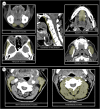Swallowing muscle mass contributes to post-stroke dysphagia in ischemic stroke patients undergoing mechanical thrombectomy
- PMID: 38890004
- PMCID: PMC11294029
- DOI: 10.1002/jcsm.13512
Swallowing muscle mass contributes to post-stroke dysphagia in ischemic stroke patients undergoing mechanical thrombectomy
Abstract
Background: Neurogenic dysphagia is a frequent complication of stroke and is associated with aspiration pneumonia and poor outcomes. Although ischaemic lesion location and size are major determinants of the presence and severity of post-stroke dysphagia, little is known about the contribution of other acute stroke-unrelated factors. We aimed to analyse the impact of swallowing and non-swallowing muscles measurements on swallowing function after large vessel occlusion stroke.
Methods: This retrospective study was based on a prospective registry of consecutive ischaemic stroke patients. Patients who underwent mechanical thrombectomy between July 2021 and June 2022 and received a flexible endoscopic evaluation of swallowing (FEES) within 5 days after admission were included. Demographic, anthropometric, clinical, and imaging data were collected from the registry. The cross-sectional areas (CSA) of selected swallowing muscles (as a surrogate marker for swallowing muscle mass) and of cervical non-swallowing muscles were measured in computed tomography. Skeletal muscle index (SMI) was calculated and used as a surrogate marker for whole body muscle mass. FEES parameters, namely, Functional Oral Intake Scale (FOIS, as a surrogate marker for dysphagia presence and severity), penetration aspiration scale, and the presence of moderate-to-severe pharyngeal residues were collected from the clinical records. Univariate and multivariate ordinal and logistic regression analyses were performed to analyse if total CSA of swallowing muscles and SMI were associated with FEES parameters.
Results: The final study population consisted of 137 patients, 59 were female (43.1%), median age was 74 years (interquartile range 62-83), median baseline National Institutes of Health Stroke Scale score was 12 (interquartile range 7-16), 16 patients had a vertebrobasilar occlusion (11.7%), and successful recanalization was achieved in 127 patients (92.7%). Both total CSA of swallowing muscles and SMI were significantly correlated with age (rho = -0.391, P < 0.001 and rho = -0.525, P < 0.001, respectively). Total CSA of the swallowing muscles was independently associated with FOIS (common adjusted odds ratio = 1.08, 95% confidence interval = 1.01-1.16, P = 0.029), and with the presence of moderate-to-severe pharyngeal residues for puree consistencies (adjusted odds ratio = 0.90, 95% confidence interval = 0.81-0.99, P = 0.036). We found no independent association of SMI with any of the FEES parameters.
Conclusions: Baseline swallowing muscle mass contributes to the pathophysiology of post-stroke dysphagia. Decreasing swallowing muscle mass is independently associated with increasing severity of early post-stroke dysphagia and with increased likelihood of moderate-to-severe pharyngeal residues.
Keywords: Dysphagia; Fiberoptic endoscopic evaluation of swallowing; Ischaemic stroke; Sarcopenia.
© 2024 The Author(s). Journal of Cachexia, Sarcopenia and Muscle published by Wiley Periodicals LLC.
Conflict of interest statement
SC Tauber has served on the scientific advisory boards of Roche and Merck & Co and has received travel and speaker honoraria from Novartis, Teva, Merck & Co, Roche, and Biogen. The remaining authors report no conflict of interests.
Figures


Similar articles
-
Early flexible endoscopic evaluation of swallowing after mechanical thrombectomy in stroke patients.Ann Clin Transl Neurol. 2024 Mar;11(3):757-767. doi: 10.1002/acn3.51998. Epub 2024 Jan 12. Ann Clin Transl Neurol. 2024. PMID: 38217067 Free PMC article.
-
Negative impact of computed tomography-based low skeletal muscle mass on swallowing recovery in patients with post-stroke dysphagia.Clin Neurol Neurosurg. 2023 Jun;229:107760. doi: 10.1016/j.clineuro.2023.107760. Epub 2023 May 5. Clin Neurol Neurosurg. 2023. PMID: 37156041
-
Impact of inspiratory muscle training on aspiration symptoms in patients with dysphagia following ischemic stroke.Brain Res. 2025 Mar 1;1850:149396. doi: 10.1016/j.brainres.2024.149396. Epub 2024 Dec 9. Brain Res. 2025. PMID: 39662789 Clinical Trial.
-
Swallowing therapy for dysphagia in acute and subacute stroke.Cochrane Database Syst Rev. 2018 Oct 30;10(10):CD000323. doi: 10.1002/14651858.CD000323.pub3. Cochrane Database Syst Rev. 2018. PMID: 30376602 Free PMC article.
-
Pneumonia, Mortality, and Other Outcomes Associated with Unsafe Swallowing Detected via Fiberoptic Endoscopic Evaluation of Swallowing (FEES) in Patients with Functional Oropharyngeal Dysphagia: A Systematic Review and Meta-analysis.Dysphagia. 2022 Dec;37(6):1662-1672. doi: 10.1007/s00455-022-10427-3. Epub 2022 Feb 28. Dysphagia. 2022. PMID: 35226186
Cited by
-
The Management of Sarcopenic Dysphagia: A Multidisciplinary Approach Leveraging Emerging Technologies.Aging Dis. 2024 Sep 26;16(5):2752-2769. doi: 10.14336/AD.2024.0741. Aging Dis. 2024. PMID: 39500356 Free PMC article. Review.
-
Unveiling the relation between swallowing muscle mass and skeletal muscle mass in head and neck cancer patients.Eur Arch Otorhinolaryngol. 2025 Jun;282(6):3173-3182. doi: 10.1007/s00405-025-09207-0. Epub 2025 Jan 25. Eur Arch Otorhinolaryngol. 2025. PMID: 39863816 Free PMC article.
-
Innovative nomogram for predictive risk stratification of aspiration pneumonia in post-stroke dysphagia patients.Front Neurol. 2025 Jun 3;16:1556541. doi: 10.3389/fneur.2025.1556541. eCollection 2025. Front Neurol. 2025. PMID: 40529443 Free PMC article.
-
Factors associated with oropharyngeal dysphagia and unsuccessful nasogastric tube removal after endovascular thrombectomy for anterior circulation stroke.Eur Geriatr Med. 2024 Dec;15(6):1669-1681. doi: 10.1007/s41999-024-01069-9. Epub 2024 Sep 24. Eur Geriatr Med. 2024. PMID: 39317881
References
-
- Cohen DL, Roffe C, Beavan J, Blackett B, Fairfield CA, Hamdy S, et al. Post‐stroke dysphagia: a review and design considerations for future trials. Int J Stroke 2016;11:399–411. - PubMed
-
- Flowers HL, Skoretz SA, Streiner DL, Silver FL, Martino R. MRI‐based neuroanatomical predictors of dysphagia after acute ischemic stroke: a systematic review and meta‐analysis. Cerebrovasc Dis 2011;32:1–10. - PubMed
-
- Warnecke T, Dziewas R, Wirth R, Bauer JM, Prell T. Dysphagia from a neurogeriatric point of view: pathogenesis, diagnosis and management. Z Gerontol Geriatr 2019;52:330–335. - PubMed
MeSH terms
LinkOut - more resources
Full Text Sources
Medical

